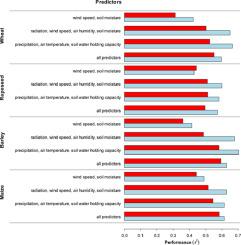Agricultural and Forest Meteorology ( IF 6.2 ) Pub Date : 2021-11-10 , DOI: 10.1016/j.agrformet.2021.108698 Gunnar Lischeid 1, 2 , Heidi Webber 1 , Michael Sommer 1, 2 , Claas Nendel 1, 3 , Frank Ewert 1, 4

|
Provisioning a sufficient stable source of food requires sound knowledge about current and upcoming threats to agricultural production. To that end machine learning approaches were used to identify the prevailing climatic and soil hydrological drivers of spatial and temporal yield variability of four crops, comprising 40 years yield data each from 351 counties in Germany. Effects of progress in agricultural management and breeding were subtracted from the data prior the machine learning modelling by fitting smooth non-linear trends to the 95th percentiles of observed yield data. An extensive feature selection approach was followed then to identify the most relevant predictors out of a large set of candidate predictors, comprising various soil and meteorological data. Particular emphasis was placed on studying the uniqueness of identified key predictors. Random Forest and Support Vector Machine models yielded similar although not identical results, capturing between 50% and 70% of the spatial and temporal variance of silage maize, winter barley, winter rapeseed and winter wheat yield. Equally good performance could be achieved with different sets of predictors. Thus identification of the most reliable models could not be based on the outcome of the model study only but required expert's judgement. Relationships between drivers and response often exhibited optimum curves, especially for summer air temperature and precipitation. In contrast, soil moisture clearly proved less relevant compared to meteorological drivers. In view of the expected climate change both excess precipitation and the excess heat effect deserve more attention in breeding as well as in crop modelling.
中文翻译:

作物产量建模中的机器学习:一个强大的工具,但不能代替科学
提供足够稳定的食物来源需要充分了解农业生产当前和未来面临的威胁。为此,机器学习方法被用于确定四种作物时空产量变异的主要气候和土壤水文驱动因素,包括来自德国 351 个县的 40 年产量数据。通过将平滑非线性趋势拟合到观察到的产量数据的第 95 个百分位,从机器学习建模之前的数据中减去农业管理和育种进展的影响。然后采用广泛的特征选择方法从大量候选预测变量中识别出最相关的预测变量,包括各种土壤和气象数据。特别强调研究确定的关键预测因子的独特性。随机森林和支持向量机模型产生了相似但不完全相同的结果,捕获了 50% 到 70% 的青贮玉米、冬大麦、冬油菜籽和冬小麦产量的空间和时间方差。使用不同的预测器集可以实现同样好的性能。因此,确定最可靠的模型不能仅基于模型研究的结果,而需要专家的判断。驱动因素和响应之间的关系通常表现出最佳曲线,特别是对于夏季气温和降水。相比之下,与气象驱动因素相比,土壤水分的相关性明显较低。



























 京公网安备 11010802027423号
京公网安备 11010802027423号